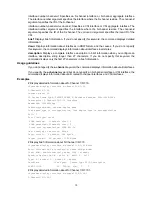
13
Usage guidelines
When the bridge receives a VDP packet (except for a De-Associate packet) from a station, it
contacts the VSI manager specified in the VDP packet to get VSI interface resources and policies.
The VSI manager ID TLV in a VDP packet carries the VSI manager's IP address. If the value for the
TLV is 0, the bridge communicates with the default VSI manager specified by this command.
Examples
# Set the IPv4 address of the default VSI manager to
192.168.100.20
.
<Sysname> system-view
[Sysname] evb default-manager ip 192.168.100.20
evb enable
Use
evb enable
to enable EVB on an interface.
Use
undo evb enabl
e to disable EVB on an interface.
Syntax
evb enable
undo evb enable
Default
EVB is disabled on an interface.
Views
Layer 2 Ethernet interface view, Layer 2 aggregate interface view
Predefined user roles
network-admin
Usage guidelines
Follow these guidelines when you enable or disable EVB on an interface:
•
Do not enable EVB on a member port of an aggregation group, or add a member port with EVB
enabled into an aggregation group. Otherwise, an error message appears.
•
Restore all default settings for an interface before enabling EVB on the interface.
•
A default S-channel is created on an interface after EVB is enabled on the interface, with both
SCID and SVID as 1. After an S-channel is created, an S-channel interface or S-channel
aggregate interface is created and operates in access mode.
•
Do not configure VLAN settings or enable any other Layer 2 protocol on an interface with EVB
enabled.
•
Delete all non-default S-channels on an interface before disabling EVB on the interface. The
default S-channel is deleted after EVB is disabled.
•
Do not enable both EVB and QinQ on the same interface.
•
Do not create a service instance for an interface enabled with EVB, and vice versa.
Examples
# Enable EVB on Ten-GigabitEthernet 1/0/1.
<Sysname> system-view
[Sysname] interface ten-gigabitethernet 1/0/1
[Sysname-Ten-GigabitEthernet1/0/1] evb enable
# Enable EVB on Bridge-Aggregation 1.
<Sysname> system-view






























